- the inflation pressure: the more a tire is hard, the less it deforms – that is obvious.
- the diameter of the tire: a tire of small diameter deforms proportionally more at the same pressure, and thus has more rolling resistence.
- the rubber utilized: a flexible rubber requires less energy for the same deformation.
- the technique of fabrication: If there is less material to deform, it takes less energy to deform it..
- the profile of the tire: a smooth tire has less material to deform, so it takes less energy to deform it.
Smooth tires have less rolling resistence.
- the cross section: wide tires roll better than narrow ones. The widely prevelent thinking that the opposite is true – that more width causes more friction – is the principal cause of bad tire choices. The three paragraphs that follow delve into this.
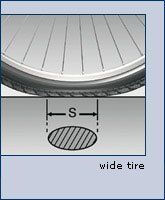
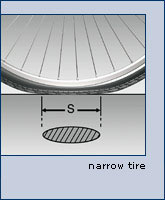
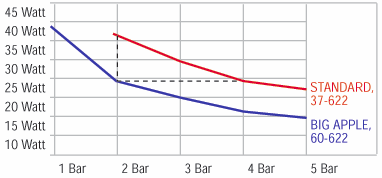 Source: Schwabe
Source: Schwabe
Large tires roll beter at the same pressure, but narrow ones can be inflated to higher pressures. At higher pressures, clearly, they are less comfortable. At less than 12 mph (20km/h), on flat terrain, a bicycle with large tires rolls faster than one with narrow tires, no doubt about it. If the pros want narrow tires, it is because of other factors. Narrow tires have less air resistance, and this becomes more and more important with higher speeds. But above all, narrow tires permit narrower rims, less tire weight, and less tube weight, and thus wheels noticably lighter and easier to accelerate thanks to their lower inertia. A bicycle that is more agile, more sensitive, and easier to accelerate – that is what racers are looking for. In addition, the slightest slope demands additional effort to overcome the weight of wider wheels and tires. [In the chart below (in French) 1 = rolling resistence, 2=the effect of gravity on a moderate hill, and 3= air resistence.]
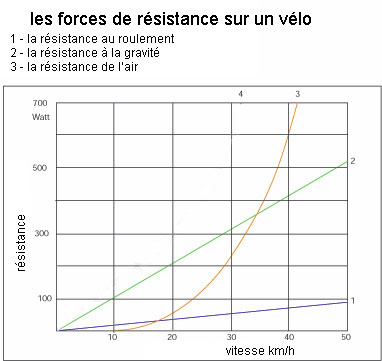
Source: Schwabe
Aquaplaning is a physical phenomenon that takes place when a vehicle advances very rapidly over ground saturated with water. Water, like all liquids, has a viscosity. Acquaplaning takes place if the evacuation of water beneath the tire isn't sufficiently rapid. In that case the tire climbs onto the water and loses its contact witht he ground, with all the risks associated. Let's be clear: no matter what its speed, even with smooth tires, it is strictly impossible for a bicycle to acquaplane! ! When a bike slips or falls after it enters into a puddle quickly, it's because of the sudden resistance of the water and the loss of control of the front wheel, which has nothing to do with aquaplaning. In fact, even with an automobile, acquaplaning occurs infrequently. It is primarily of concern for trucks and for landing airplanes. Applying mathmatical formulas, a bicycle would have to move at more than 120 mph (200 km/h) for aquaplaning to occur.
Therefore the correct response to the question posed on the Internet is exactly the contrary to the one typically given. "To avoid slipping on a wet road surface, ride with tires that are entirely smooth! "
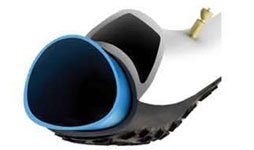
There exist more than thirty sizes of bike tires on the market, but most adult bikes are equipped with only two sizes:
- 26" : it is the size of almost all mountain bikes.
- 28" : also known under the French designation of 700C, it's the size of tire one finds on most road bikes, hybrids, city bikes and touring bikes.
On the forums, there are constant debates about the best choice among these sizes for bicycle treks. The reasons generally given for choosing 26" wheels are that they are stronger and that they will be easier to find on the other side of the world. These two affermations are unfortunately and sadly put forth be some fabricators of touring bikes who think they have found a way to distinguish themselves . Le us examine each of the reasons given.
- Easier to find in Africa, Asia ,Latin America, etc. Hummm ... Suppose that you are in some small village,let's say on a national highway between two cities of Chili, and you tear the casing of your tire, an incident that requires its immediate replacement. Do you think that a wonderful flat-resistant Marathon brand tire awaits you in the the obscure boutique that you will have already had trouble finding? No, it will be a very cheap nylon tire, that under your load is going to go flat rapidly and frequently. Don't kid yourself, iff you want a quality tire, it will have to be ordered either by the shop or by you on the Internet.. So remember: whether 26" or 28", you are not going to find a quality tire in isolated places, nor any other quality bike parts that might break. So, to tide you over, why buy a low quality tire. Carry a spare foldable tire with you, and order another good quality tire when you can.
It is true that26" wheels are stronger –if the components and mounting are identical. However, is that necessary given that good quality double wall rims are so much stronger than in the past? Moreover, there are other things to consider before jumping to the conclusion that 26" wheels are a better choice for a distant trip. A larger tire at the same pressure has less deformation to attain the same level of surface contact. Some studies show that that a 26" tire will have over 10% more rolling resistance than a 700C. Is this really what you want?
Some people believe thatt the size of wheels ought to follow the size of the frame, and there, idealy, the size of the biker, because a well proportioned bike (and off the shelf bikes are not well proportioned) rides better empty or loaded, is more stable, climbs mor easily, and so on. So if one is going to put up with the higher roling resistence, 26" frames should logically be reserved for very small people. Perhaps tandems destined for loaded touring are also an exception, because they require very strong rims. Otherwise, the only special preparations needed for trips in distant lands should be to take with you one or two foldable tires and some extra tubes..
The bicycle industry, as with other industries, seeks to simplify its production and reduce its costs. So why not use the same frame for a road (racing) bike and a touring bike. It is possible if they replace a so called 28" racing wheel (actual wheel diameter of 622mm) holding a 23 mm tire (overall 670 mm in diameter) with 650 B wheels (actual wheel diameter of 584mm) and add tires that are 36mm wide, which gives them an outside tire dimension of 655mm, which is only 2.2% less. So they can mount 650 Bs in the frame and the fork of a road bike without having to make too many modifications, and ythey will have room for femders (mud guards). For the user, these bikes are expensive and have no advantages.
What about converting your existing road (racing) bike into a bike more suitable for rough city streets using 650 B wheels with wide tires? Its often possible. Quick research in the USA (2015) turned up one quality wheelset for about $300 (2015), $40 and up for new tires, $70 or more for new brakes, and add several hours of labor to make the modifications if you are not able to do it yourself.
Are you going to want to carry panniers? If so, there's only a slight chance that your bicycle will have brazes. However, if so,with the extra weight that you will be carrying, are you going to want lower gears? If so, you will need to change your chain rings and almost surely your derailers. If you are going to use the bike in hilly areas, you may need to go to a tripple chainring and you certainly will have to count several hundred additional dollars for the modifications. Perhaps you would be better off keeping your road bike for when you want to ride it, and buying a new hybrid or touring bike.
However, let us suppose that you have an old steel bike frame lying around from decades ago. It may be worth retrofitting it with new wheels (whether with 700 Cs or 650 Bs), changing out the casette and chainrings, and so on. You might end up with a nice touring bike for less than the cost of a new one.
The European Tire and Rim Technical Organization has defined international norms that completely avoid confusion in measuring rims and tires.The E.T.R.T.O. system uses two number. The first is for a tire its external cross section where it goes into the rim, and for the rim its internal width where the tire fits; the second is for a tire the inside diameter, while for the rim it is the point at which the inside of the tire rests.
It is obvious that the second E.T.R.T.O. number must match between the tire and the rim. They must be exactly the same for the tire to mount in the rim. For the second number there is a range of tires that can mount in a rim. The E.T.R.T.O. makes things simple and eliminates ambiguity. Thus a 16 x 1 3/8 x 1 3/8 becomes a 37-349 and a 16 x 1¾ x 1 ½ becomes 38-305. This example makes clear that under the old system 16" wasn't always the same diameter. The chart below has all the old sizes and their new designation. [In the French chart below "largeur" = width, "jante" = "rim" and "tringle du pneu" = "hook of the tire".

|
|
||||||||||||||||
| width of the interior of the rim in mm | 18 | 20 | 23 | 25 | 28 | 32 | 35 | 37 | 40 | 44 | 47 | 50 | 54 | 57 | 60 | 62 |
| 13 | x | x | x | x | ||||||||||||
| 15 | x | x | x | x | ||||||||||||
| 17 | x | x | x | x | x | x | x | x | x | |||||||
| 19 | x | x | x | x | x | x | x | x | ||||||||
| 21 | x | x | x | x | x | x | x | x | x | x | ||||||
| 23 | x | x | x | x | x | x | x | x | x | |||||||
| 25 | x | x | x | x | x | x | x | |||||||||
| 27 | x | x | x | x | x | x | ||||||||||
| 29 | x | x | x | x | ||||||||||||
Size: tibes are. like tires, designated by their widthl and by their diameter. The latter demension needs to correspond to that of the tires and rims. Since the rubber is elastic, a tube will often serve for several widths of tires. Ideally, the minimum size of the tube should correspond with the size of the tire: the less the rubber is stretched the more resistent it will be to flats and the longer it will last. For example, if you have the choice of either a 28/40-622 tube or a 40/47-622 for a tire 40-622, choose the second one.
Material : tubes are made in either Butyl or in Latex. Butyl is very elastic and very impervious to air; latex has a coefficient of elasticity much higher than Butyl, which makes it difficult to pierce, and it is also lighter. Its principal fault is its porosity that requires checking tire pressure for each outing, perhaps daily, making it impractical for city biking and touring. It is generally used by racers and mountain bikers.
Valve : The valve is attached to the rubber during vulcanization. Thereare four types.
• Schrader : its the valvue found on car tires, which permits blowing up tires at service station.elle permet de gonfler ses pneus à une station service. With a fairly large diameter, it is often associated with large rims for large tires.: mountain bikes, childrens bikes, city bikes.. Its problem: it wears out the seals of bike pumps faster than other valves, and is leaks air more rapidly.
• Presta : it is thin and has an integrated plug that one must unscrew before being able to blow up the tube and screw closed afterwards. The little screw makes it fragile delicate to handle than the other valves, but also less likely to leak and easier to use with a hand pump. on the other hand. You must never use a presta valve in a schrader rim opening.
• Dunlop : it is widely used on Dutch bikes and elsewhere in the world, but seldom seen in the USA, England or France. It is robust, easy to use, and seals well.
• Regina : it ressembles the Presta and is utilized exclusively in Italie.
Adapters can be useful; they are tiny, and cost little.
The valve should always come through the rim at a right angle. The tube should always be correctly positioned, without a fold, or a a bulge.


Rim strips/tape : it covers all of the holes in the rim, and prevents the tube from contacting the spoke screws, for which the mechining can be rough. Rubber or cloth tape should only be used on simple rims; on a double rim a more rigid material is necessary, that wont sink deeply into the access holes for the rim screws under the pressure of air. The rim strips/tabe needs to cover the entire with of the rim to prevent movement during use, which can abrade the tube and lead to flats.

| ETRTO | english system | french system | |
| 7" | 47-93 | 7 x 1 3/4 | |
| 8" | 47-94 |
20 x 47-50 |
|
| 50-94 | 200 x 50 | ||
| 54-110 | 8 x 2 1/8 8 1/2 x 2 |
||
| 32-137 | 8 x 1 1/4 | ||
| 10" | 54-152 44-194 |
10 x 2 10 x 1 5/8 |
|
| 11" | 47-222 | 11 x 13/4 | |
| 12" | 47-203 | 12 1/2 x 1.75 12 1/2 x 1.90 |
|
| 54-203 | 12 x 1.95 | ||
| 57-203 | 12 1/2 x 2 1/4 R | ||
| 62-203 | 12 1/2 x 2 1/4 | ||
| 32-239 | 12 1/2 x 1 3/8 x 1 1/4 | 300 x 32A | |
| 57-239 | 12 1/2 x 2 1/4 | 300 x 55A | |
| 14" | 57-251 | 14 1/2 x 2 1/4 | 300 x 55A |
| 47-254 | 14 x 1.75
14 x 1.90 |
||
| 40-279 | 14 x 11/2 | 350 x 38B | |
| 37-288 | 14 x 1 5/8 x 1 3/8 | 350A 350A 350A Confort 350A Ballon 350A 1/2Ballon 350 x 32A |
|
| 40-288 | 14 x 1 5/8 | 350 x 38A | |
| 44-288 | 14 x 1 5/8 x 1 3/8 | 350A 350 x 42A |
|
| 32-298 | 14 x 1 1/4 | 350A 350 x 32A |
|
| 16" | 40-305 | 16 x 1.50 | |
| 47-305 | 16 x 1.75 16 x 1.90 |
||
| 54-305 | 16 x 1.95
16 x 2.00 |
||
| 57-305 | 16 x 2.125 | ||
| 40-330 | 16 x 1 1/2 | 400 x 38B | |
| 28-340 | 400 x 30A | ||
| 32-340 | 16 x 1 3/8 x 1 1/4 | 400A 400 x 32A |
|
| 37-340 | 16 x 1 3/8 x 1 1/4 | 400 x 35A 400A Confort 400A Ballon 400A 1/2 Ballon |
|
| 44-340 | 16 x 1 5/8 | ||
| 28-349 | 16 x 11/8 | ||
| 32-349 | 16 x 11/4 NL | ||
| 37-349 | 16 x 1 3/8 | ||
| 17" | 32-357 | 17 x 1 1/4 | |
| 37-369 | 17 x 1 1/4 | ||
| 18" | 28-355 | 18 x 1 1/8 | |
| 40-355 | 18 x 1.50 | ||
| 47-355 | 18 x 1.75 18 x 1.90 |
||
| 37-387 | 18 x 1 3/8 | ||
| 40-387 | 18 x 1 1/2 | ||
| 28-390 | 18 x 1 1/8 | 450 x 28A
450A |
|
| 37-390 | 18 x 1 3/8 | 450 x 35A 450A 450A Confort |
|
| 55-390 | 450 x 55A | ||
| 57-390 | 450 x 55A 450A |
||
| 37-400 | 18 x 1 3/8 | ||
| 20" | 54-400 | 20 x 2 x 1 3/4 20 x 2F4J |
|
| 28-406 | 20 x 1 1/8 | ||
| 32-406 | 20 x 1.25 | ||
| 35-406 | 20 x 1.35 | ||
| 37-406 | 20 x 1 3/8 | ||
| 40-406 | 20 x 1.50 | ||
| 44-406 | 20 x 1.625 | ||
| 47-406 | 20 x 1.75 20 x 1.90 |
||
| 50-406 | 20 x 2.00 | ||
| 54-406 | 20 x 2.00 | ||
| 57-406 | 20 x 2.125 | ||
| 54-428 | 20 x 2.00 | ||
| 40-432 | 20 x 1 1/2 | ||
| 37-438 | 20 x 1 3/8 | 500A | |
| 40-438 | 20 x 1 3/8 | 500 x 38A | |
| 28-440 | 500 x 28A
500A |
||
| 40-440 | 20 x 1 1/2NL | 500 x 38A | |
| 28-451 | 20 x 1 1/8 | ||
| 37-451 | 20 x 1 3/8 B.S. | ||
| 22" | 44-484 | 22 x 15/8 x 11/2 | |
| 25-489 | 22 x 1.00 | ||
| 37-489 | 22 x 1 3/8 NL | ||
| 40-489 | 22 x 1 3/8 x 1 1/2 | ||
| 50-489 | 22 x 2.00 | ||
| 28-490 | 550 x 28A 550A 550A Standard |
||
| 32-490 | 22 x 1 3/8 x 1 1/4 | 550 x 32A 550A |
|
| 37-490 | 22 x 13/8 | 550 x 35A
550A Confort |
|
| 37-498 | 22 x 1 3/8 x 1 1/4 | ||
| 32-501 | 22 x 1 1/4 | ||
| 37-501 | 22 x 1 3/8 | ||
| 24" | 40-507 | 24 x 1.50 | |
| 44-507 | 24 x 1.625 24 x 1.75 |
||
| 47-507 | 24 x 1.75 24 x 1.85/1.90 |
||
| 49-507 | 24 x 1.85 | ||
| 50-507 | 24 x 1.90/2.00 24 x 2.00 24 x 2.125 |
||
| 54-507 | 24 x 2.10 | ||
| 57-507 | 24 x 2.125 24 x 2.00 |
||
| 60-507 | 24 x 2.35 | ||
| 44-531 | 24 x 1 5/8 x 1 1/2 | ||
| 40-534 | 24 x 1 1/2 | ||
| 25-540 | 24 x 1.00 | ||
| 32-540 | 24 x 1 3/8 x 1 1/4 24 x 1 3/8 |
||
| 37-540 | 24 x 1 3/8 | ||
| 40-540 | 24 x 1 3/8 x 1 1/2 | ||
| 22-541 | |||
| 25-541 | 600 x 25A | ||
| 28-541 | 600 x 28A 600A 600A Standard |
||
| 32-541 | 24 x 1 3/8 x 1 1/4 N4 | 600 x 32A | |
| 37-541 | 600 x 35A 600A Confort 600A Ballon 600A 1/2 Ballon |
||
| 26" | 25-559 | 26 x 1.00 | |
| 35-559 | 26 x 1.35 | ||
| 37-559 | 26 x 1 5/8 x 1 3/8 26 x 1.40 |
||
| 40-559 | 26 x 1.50 | ||
| 44-559 | 26 x 1.625 26 x 1.50/1.75 |
||
| 47-559 | 26 x 1.75
26 x 1.85/1.90 |
||
| 50-559 | 26 x 1.90 26 x 1.95 26 x 1.90/2.00 |
||
| 54-559 | 26 x 1.95
26 x 2.10 |
||
| 57-559 | 26 x 2.125
26 x 2.20/2.25 |
||
| 60-559 | 26 x 2.35 | ||
| 62-559 | 26 x 2.50 | ||
| 20-571 | 26 x 3/4 | 650 x 20C | |
| 23-571 | 26 x 7/8 | 650 x 22C | |
| 40-571 | 26 x 1 1/2 CS 26 x 1 3/8 x 1 1/2 NL 26 x 1 5/8 x 1 1/2 |
650 x 35C 650 x 38C |
|
| 47-571 | 26 x 1 3/4 650 CS confort |
650 x 45C | |
| 54-571 | 26 x 2 x 1 3/4 | 650 x 50C | |
| 28-584 | 26 x 1 1/8 x 1 1/2 | 650 x 28B | |
| 32-584 | 650 x 32B | ||
| 35-584 | 26 x 1 3/8 x 1 1/2 | 650 x 35B 650B Standard |
|
| 37-584 | 26 x 1 1/2 x 1 3/8
26 x 1 1/2 |
650 x 35B | |
| 40-584 | 26 x 1 5/8 x 1 1/2 | 650 x 42B
650B Semi-Confort |
|
| 20-590 | 650 x 20A | ||
| 25-590 | 26 x 1 1/8, 1 1/4 26 x 1 3/8 - 1 1/4 |
650 x 32A | |
| 28-590 | 26 x 1 1/8 | 650 x 28A | |
| 32-590 | 26 x 1 1/4
26 x 1 3/8 x1 1/4 |
650 x 32A | |
| 35-590 | 26 x 1 3/8 | 650 x 35A | |
| 37-590 | 26 x 1 3/8 | 650 x 35A 650A |
|
| 40-590 | 26 x 1.50 28 x 1 3/8 x 1 1/2 |
650 x 38A | |
| 44-590 | |||
| 32-597 | 26 x 1 1/4 | ||
| 27" | 40-609 | 27 x 1 1/2 | |
| 20-630 | 27 x 3/4 | ||
| 22-630 | 27 x 7/8 | ||
| 25-630 | 27 x 1.00 27 x 1 1/16 |
||
| 28-630 | 27 x 1 1/8 27 x 1 1/4 Fifty 27 x 1 1/4 |
||
| 32-630 | 27 x 1 1/4 | ||
| 28/32-630 | 27 x 1 1/4 | ||
| 35-630 | 27 x 1 3/8 | ||
| 28" | 18-622 | 28 x 3/4 | 700 x 18C |
| 19-622 | 700 x 19C | ||
| 20-622 | 28 x 3/4 | 700 x 20C | |
| 22-622 | 28 x 7/8 | 700 x 22C | |
| 23-622 | 28 x 7/8 | 700 x 23C | |
| 25-622 | 28 x 1.00, 1 1/16 | 700 x 25 | |
| 30-622 | 28 x 1.20 | 700 x 28C | |
| 28-622 | 28 x 1 5/8 x 1 1/8 | 700 x 30C | |
| 32-622 | 28 x 15/8 x 11/4 | 700 x 32 700C COURSE |
|
| 35-622 | 28 x 15/8 x 13/8 | 700 x 35C | |
| 37-622 | 28 x 1 5/8 x 1 3/8 | 700 x 35C | |
| 40-622 | 28 x 1.50 28 x 1 5/8 x 1 1/2 |
700 x 38C | |
| 42-622 | 28 x 1.60 | 700 x 40C | |
| 44-622 | 28 x 1.625 | 700 x 42C | |
| 47-622 | 28 x 1.75 | 700 x 45C | |
| 50-622 | 28 x 1.90 28 x 2.00 |
||
| 60-622 | 28 x 2.35 | ||
| 32-635 | 28 x 1 1/2 x 1 1/8 | 770 x 28B
700 x 28B |
|
| 40-635 | 28 x 1 1/2 28 x 1 1/2 x 1 3/8 |
700 x 38B 700 x 35B 700 Standard 700B Standard |
|
| 44-635 | 28 x 15/8 x 11/2 | 700 x 40/42B | |
| 28-642 | 28 x 1 3/8 x 1 1/8 | 700 x 28A | |
| 37-642 | 28 x 1 3/8 | 700 x 35A |
Courtesy of www.LesVelosDePatrick.com
promouvoir le vélo pour les loisirs, les déplacements, la santé, et un meilleur avenir ™
Loosely translated into English by David May, www.europebicycletouring.com